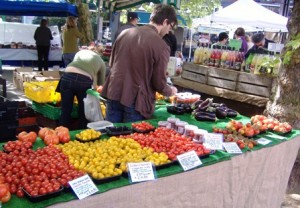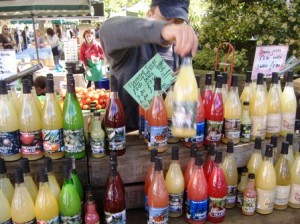- How should journalists report biodiversity loss?
- Ireland maps its threatened species, including a crop wild relative or two.
- Eat like a nomad.
- Why agriculture was such a bad idea.
- “The heightened voyaging from A.D. 1000 to 1450 in eastern Polynesia was likely prompted by ciguatera fish poisoning.”
- Is Floyd Zaiger the most prolific fruit breeder in the world? Read about his “designer fruits.”
- “It is truly the apricots that have kept me interested and focused at this job for the past 22 years.”
- Jordan’s Bedouins struggling to cope.
- Donkeys running for their lives in Ghana.
- Chile’s winemakers move south.
- The continuing success story that is Cuban urban agriculture.
Nibbles: Sacred sites, Pollan, Atlas of Food, Bison, Urban trees
- Sacred places conserve biodiversity.
- Amy Goodman interviews Michael Pollan.
- Mapping food.
- Bringing back the prairie.
- Urban forestry in Toronto.
Visualizing agrobiodiversity in markets
I’ve just come across two Flickr groups which are intensely interesting from an agrobiodiversity perspective. Flickr is a photo sharing site, and I have in fact blogged about it before here, for example on how it could be used to map crop diversity. The two groups bring together photos taken in markets, with a lot of fruits and vegetables featured. As with my previous post on tomatoes, have a look at the mapping option in particular. A great time-waster, but I bet it could be used to look at geographic patterns in vegetable diversity in markets.
So much, much more than a weed
According to self-described “cultivator” David Randall in The Independent, it’s going to be a bumper year for dandelions in the UK.
Yet not everyone is clapping their hands with glee. According to reports in less ecologically sensitive newspapers, keen gardeners and lawn obsessives see dandelions as trouble, blemishes to their idea of contrived perfection, the removal of whose deep taproots can rick the sturdiest of backs. To them, dandelions are the enemy, insurgent forces of nature, forever pushing aside the “real” garden flowers, and taking over. They are thus condemned, in that most loaded of horticultural terms, as “weeds”.
This word, to those of us who have been gardening with dandelions for years, is not only wrong, but hurtful. Taraxacum officinale, as we cultivators call it, is a much undervalued addition to any plot. Not only do its golden rosettes brighten the dingiest corner, but you can use it to construct a salad, make an acceptable table wine, or even, when it runs to seed, tell the time. And you can’t say that about all those bloody purple alliums of which Chelsea’s show gardeners are so fond.
Quite right. Dandelions have a long history of use in medicine, yes, but also food. Although they do take some preparation. And of course there’s wine too. All this, plus an interesting taxonomy, and an endangered endemic relative. What more can you ask for? Weed indeed.
Farmers’ market fails to market diversity
Wandering around London on Friday, we came across the Pimlico Road Farmers’ Market. A couple of dozen stall selling everything from fruits and vegetables to cheese to all kinds of meat products, mostly sourced locally, meaning within 100 miles of the M25, the motorway that goes all the way around London. Friendly people. Beautiful produce, beautifully displayed. All impeccably organically certified — signs to that effect were everywhere. Made artisanally, naturally, according to traditions which no doubt trace their origins back to the mist-shrouded times of, well, the last Tory government, probably. And yet, and yet…
Apart from one stall selling tomatoes

and another one selling apples and apple products

there was really no indication that agrobiodiversity was in any way valued, either by the sellers or buyers.
None of the stalls had more than one or two varieties of any of the fruits and vegetables on display. Ok, I thought, fair enough, we’re not dealing with a huge catchment area. But there was not even any mention of variety names on the labels. Maybe they’re all rather boring commercial cultivars and breeds, and the stall owners don’t want to draw attention to that fact. The European Union doesn’t make it particularly easy to grow heirlooms, as we’ve pointed out here before. And indeed a brief chat with a couple of stall holders did in fact reveal that none of the veggies on display were particularly noteworthy local varieties. Pity. It seems that the fact that produce is organically grown is an immeasurably more important selling point than its status as an ancient landrace, at least in this market in an affluent part of London, which I found surprising. I wonder if some enterprising student is making a study of all such markets across London.
Excellent pork pies though.